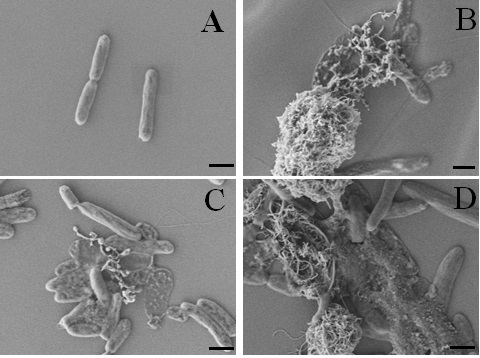Functional nanomaterials as antimicrobial agents
Hyperbranched dendritic polymers were modified with suitable functional groups having antimicrobial properties (e.g. quaternary ammonium groups, guanidinium moieties, triphenylphosphonium groups, etc.). Their bioactivity and mechanism of action were evaluated on various types of bacteria and also on plant pathogenic fungi.1
Moreover, research is focused on the development of antibacterial agents based on the aqueous dispersed carbon-based materials (carbon nanotubes, carbon nanodisks and graphene oxide) functionalized with positively charged dendritic polymers exhibiting antibacterial properties.2-5 The synthesis of hybrid nanomaterials was realized by either covalent or physical (electrostatic) interactions following eco-friendly and facile routes that can be easily adopted by the industry. The antibacterial properties of the developed nanomaterials were assessed against selected bacterial strains according to approved standards.


Applications
Implants for dental and orthopedics applications
Functionalized hyperbranched polymers incorporating selected antibiotics or exhibiting antibacterial properties by their own, were developed and integrated into novel biomimetic peptide-enriched silk fibroin matrices in order to prepare implants that inhibit the biofilm formation and restore the damaged bone and periodontal tissues in the case of implant-related infections. This work was performed in the framework of project ANNAFIB.
http://www.annafib.eu/

Dendritic polymer-functionalized nanostructured composites
Dendritic polymer-functionalized carbon-based materials were used as nanofillers into polymeric matrixes affording nanostructured composites that exhibit various properties such as optical transparency, improved mechanical, flame retardancy and UV-resistant properties, extremely high antibacterial behavior, etc., depending on the coating applications.2,5 Additionally, advanced polymeric nanocomposite membranes were developed to meet specific water treatment applications by tuning their structure and physicochemical properties (e.g. hydrophilicity, porosity, thermal and mechanical stability) and introducing unique functionalities (e.g. antibacterial, anti-fouling, adsorptive capabilities). Specifically, carbon-based materials modified with functional dendritic polymers were used as nanofillers into polymeric matrices, i.e. poly(vinyl alcohol) and poly(vinylidene fluoride), affording nanostructured composites suitable for water treatment that demonstrated high permeability and rejection as well as excellent mechanical, anti-fouling and anti-bacterial properties.3

Selected publications
- M. Lykogianni, E.-A. Papadopoulou, A. Sapalidis, D. Tsiourvas, Z. Sideratou, K. A. Aliferis, Metabolomics reveals differential mechanisms of toxicity of hyperbranched poly(ethyleneimine)-derived nanoparticles to the soil-borne fungus Verticillium dahliae Kleb, Pesticide Biochemistry and Physiology, 165, 104535 (2020).
- A. Sapalidis, Z. Sideratou, K.N. Panagiotaki, E. Sakellis, E.P. Kouvelos, S. Papageorgiou, F. Katsaros, Fabrication of antibacterial PVA nanocomposite films containing dendritic polymer functionalized multi-walled carbon nanotubes, Frontiers in Materials,5, Article number 11(2018). DOI: 10.3389/fmats.2018.00011.
- M. Antoniou, A. Sapalidis, Z. Sideratou, Functionalization of Carbon-Based Additives. In: Membrane Desalination: From Nanoscale to Real World Applications. A. Sapalidis (Ed.). Boca Raton: CRC Press (2021). DOI: 10.1201/9780429020254-3.
- N. S. Heliopoulos, G. Kythreoti, K.M. Lyra, K.N. Panagiotaki, A. Papavasiliou, E. Sakellis, S. Papageorgiou, A. Kouloumpis, D. Gournis, F.K. Katsaros, K. Stamatakis, Z. Sideratou, Cytotoxicity effects of water-soluble multi-walled carbon nanotubes decorated with quaternized hyperbranched poly(ethyleneimine) derivatives on autotrophic and heterotrophic gram-negative bacteria. Pharmaceuticals 13, 293 (2020). DOI:10.3390/ph13100293.
- N. S. Heliopoulos, Z. Sideratou, F. Katsaros, K. Stamatakis, S. Papageorgiou, Th. Tsoufis, “Novel Dendritic polymer-functionalized nanostructured carbon-based materials with antibacterial properties and their effect in the photosynthetic process”, Filed in Greek Patent Office, Application Number 20140100263/2-5-2014. Patent number 1008659/18-01-2016, as well as in European Patent Office, Application Number EP15001320/4-5-2015.